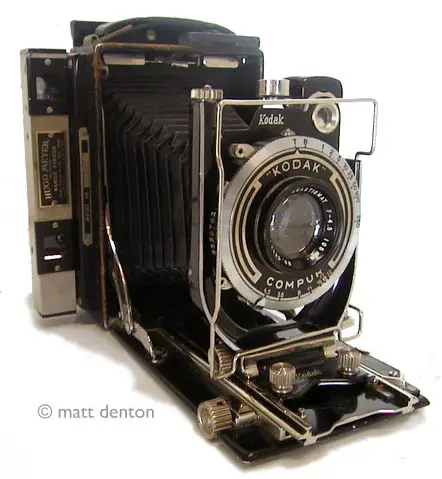- Produced 1932-40s Kodak AG Dr. Nagel-Werk, Stuttgart, Germany
- Film type 6.5cm x 9cm sheet film
- Picture size 6.5 x 9cm
- Weight 1lb, 13oz (822.2g) with ground glass back
- Lens Kodak Anastigmat 105mm f4.5 (4.5-32)
- Focal range 4′ to infinity
- Filter size accepts Series VI with the 1 1/4″ (31.5mm) slip-on adapter
- Shutter Compur
- Shutter speeds T, B, 1/10-250
- Viewfinder popup wire frame finder plus angled mirror finder; here also with aftermarket rangefinder
- Exposure meter none
Overview
The box was smaller than I expected. Eh? Why? I don’t know. Well it was extremely cleverly packed for one. And for another, frankly, I didn’t even know they made sheet film cameras this small. Of course I knew that as a 6×9 camera it wasn’t going to be a St. Ansel rig that would require its own pack animal but still…
It’s about 5 inches by 3 inches by 1 1/2 when folded up. It’s ingenious is what it is. The fingerprints of Dr. Nagel’s world-famous design are all over this camera. The compactness of the box, the cleverly constructed flip-out finders, the smoothness of the focusing wheel, the bubble level in the angle finder, and just the amazing build quality in general are all indicators of the kind of quality design and construction I’m used to seeing from the designer of the Retina cameras. Dr. Nagel of course was the German camera designer that ran Stuttgart’s famous Nagel-Werke until Kodak bought it and turned it into Kodak AG, then kept him on as designer for what I think are Kodak’s best cameras. I don’t really even think of them as Kodak cameras as much as Nagel cameras. I’m guessing I’m not alone on that one.
I think now that Kodak tried to take what it learned from Dr. Nagel’s designs and replicate them for the masses in its own US-made cameras like the Monitor and Vigilant, both sturdy cameras themselves though not quite approaching the cleverness and quality of the Nagel-Werke cameras. The weight and features of this box remind me very much of my Vigilant Six-20, I believe it’s the same lens as well. I have seen a Recomar with a Leitz lens, I don’t know if that was an after-market upgrade or not. I’m not sure what other shutter and lens combinations there may have been. I do know that there is also a Recomar 33 which is a 4×5 plate camera, and that the Recomar is a fairly famous design that was copied by other makers.
As I said, it’s a plate camera, it’s got interchangable backs and is basically a new animal for me. I think I’ve figured most of it out though. Put the ground glass back on for composing and focusing (it has a nice pop-up hood so you can actually see the ground glass in daylight), replace it when ready with a loaded film back, remove the darkslide and take your picture. Like press cameras, this has adjustments for vertical (top wheel) and horizontal (bottom wheel) shifting of the lens. The camera itself opens with hidden button on the top center of the case under the handle, then you pull the lens out into the slide rails till it hits the stop next to the distance scale (shifting the left slide handle inward when necessary). Focusing is then done with the wheel on the door, you pull it out to unlock it and then rotate to move the ‘sled’ in and out. A wire frame flips out as does the pop-up finder on the outside of the case. I expect it will come to me in time why you would need to fit an after-market rangefinder to a camera that already has an angle finder, a frame finder, a distance scale and a ground glass screen for focusing… In the meantime I need to adjust the thing since it’s inaccurate!
To close it up you fold up the finders, push the lens all the way back into the box, press on the elbows of the struts to unlock them, and fold it all up. Compact and clever….
Repairs
Cleaned up the glass, including unscrewing the front group and cleaning the inside of the rear lens element with the shutter on T…
Tips & Tricks
Takes the same Series VI adapter as the Kodak 35 RF, not too surprising I guess since it’s the same lens (Anastigmat) and they were basically contemporary. What is really surprising is that I actually have two of the things. Before coatings, there were filters…
Related Links
- J & C Photography (great store!) sells sheet film in many sizes among other things… for this size look under ‘centimeter film’
